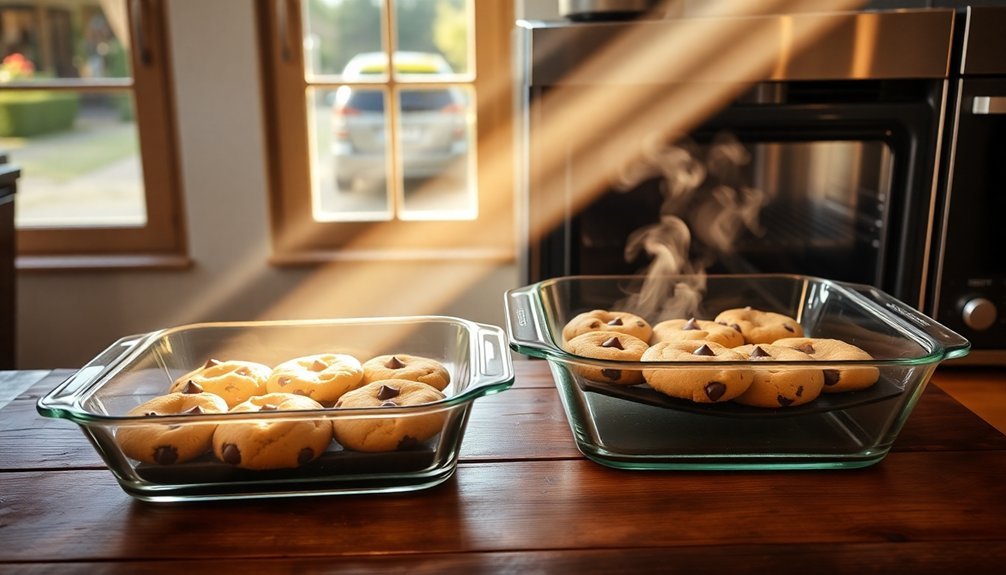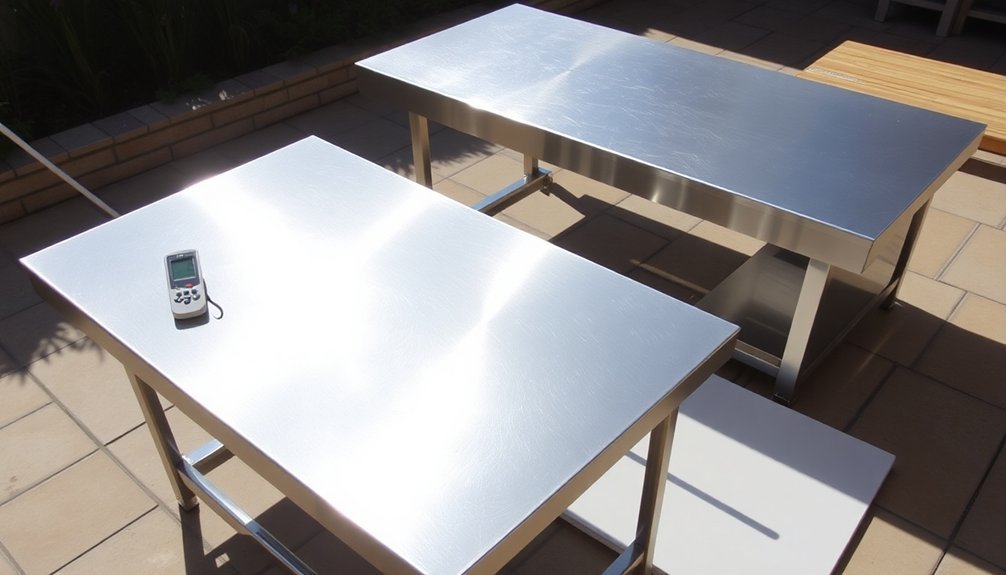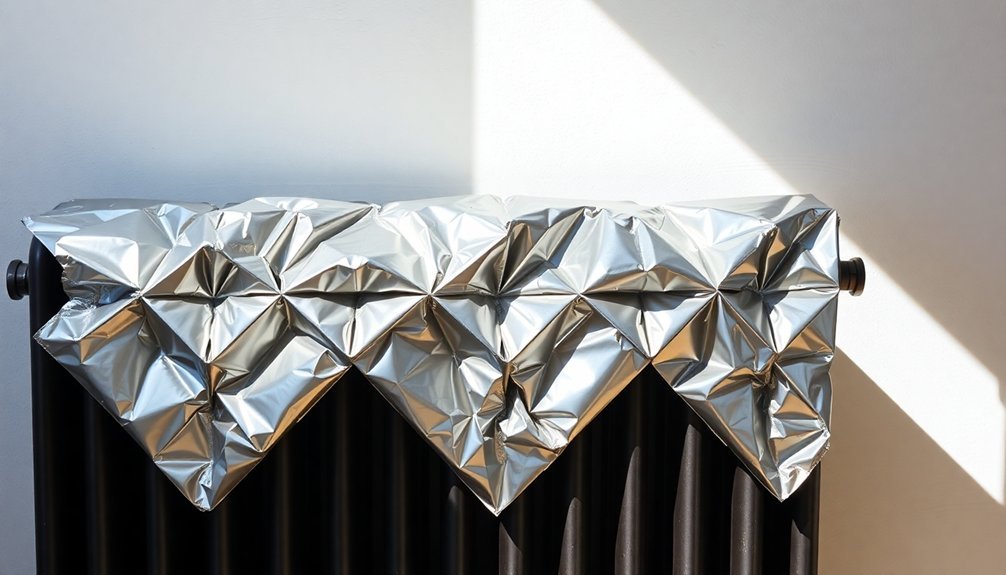To convert your favorite baked goods from oven to solar cooking, you'll need to multiply traditional baking times by 1.5 to 2.0. For cookies that usually take 12 minutes, plan for 18-24 minutes in your solar oven. Muffins typically need 30-35 minutes, while bread requires 45-60 minutes under full sun. You'll get the best results between 10 am and 4 pm when sunlight is strongest. Remember to preheat your solar oven for at least 30 minutes and adjust for weather conditions like humidity and cloud cover. Discover how environmental factors and recipe modifications can enhance your solar baking success.
Understanding Solar Temperature Ranges

When planning to cook with a solar oven, understanding temperature ranges is essential for successful results. You'll find different solar ovens offer varying heat capabilities, with box-type models reaching 160°F to 400°F and parabolic cookers climbing as high as 800°F.
For most baking needs, aim for temperatures between 300°F and 400°F. Expect cooking times to be 1.5 to 3 times longer than traditional oven methods.
You'll achieve the best results during peak hours from 11:00 am to 3:00 pm, when sunlight is strongest. Your location matters too – southern regions closer to the Equator provide more intense sunlight and longer cooking periods.
Remember to monitor internal temperatures with a thermometer and maintain at least 180°F for safe cooking. Use dark-colored cookware and proper insulation to maximize heat retention, and reposition your oven every 30 minutes to follow the sun's movement.
Essential Time Conversion Calculations
To convert traditional baking times for solar ovens, you'll need to multiply your standard recipe times by 1.5-2.0 to account for lower temperature ranges.
You'll want to adjust these multiplication factors based on your local weather conditions, consulting provided adjustment tables for cloud cover, wind speed, and humidity levels.
When temperatures drop below ideal ranges, you can extend cooking times further using the weather impact charts while monitoring your food's internal temperature for safety. For best results, always use a meat thermometer to verify your food has reached the proper internal temperature before consuming.
Basic Solar Multiplication Factors
Understanding solar baking time calculations requires familiarity with basic multiplication factors.
When converting conventional recipes to solar baking times, you'll need to adjust based on your solar oven's temperature range. For summer temperatures of 300-350°F, use a 1:1 multiplication factor. However, during winter when temperatures reach only 250-300°F, multiply your conventional baking time by 1.3.
You'll also need to factor in the time of day, as you're limited to peak sun hours between 10:00 a.m. and 2:00 p.m. Using tight-fitting container lids will help maintain consistent temperatures during baking.
Plan for a minimum of two hours of preheating plus your adjusted baking time. Remember that your DNI must exceed 700 W/m² for effective baking, and you'll need at least three continuous hours of sunlight for a successful batch.
Weather Impact Adjustment Tables
Precise weather adjustments can make or break your baking results, especially when dealing with humidity, temperature, and altitude variations. You'll need to adapt your recipes based on environmental conditions to achieve consistent results.
| Condition | Adjustment | Impact |
|---|---|---|
| High Humidity | Reduce liquids 25% | Prevents spreading |
| Low Humidity | Add 1 tbsp liquid | Maintains moisture |
| High Altitude | Increase temp 25°F | Compensates pressure |
| Warm Kitchen | Chill dough longer | Controls spread |
| Cold Kitchen | Add 3-5 min time | Guarantees doneness |
When baking on humid days, start by reducing your liquid ingredients by 25%. You can always add moisture back in small increments. For temperature variations, remember that higher temps mean shorter bake times – calculate using the percentage difference between temperatures. At higher altitudes, you'll need to increase both temperature and bake time while reducing leavening agents. Storing ingredients in the refrigerator or freezer can prevent excess moisture absorption during humid conditions.
Weather Impact On Baking

Weather conditions play a significant role in how your baked goods turn out, affecting everything from ingredient behavior to cooking times.
When humidity's high, you'll need to reduce liquids by about a quarter and extend baking time by 3-5 minutes since your dry ingredients will absorb more moisture. You can store them in the fridge to prevent this absorption.
Air temperature impacts how quickly fats melt in your dough. If your kitchen's warm, use chilled ingredients to slow down butter melting. For cold kitchens below 70°F, warm your flour to avoid crumbly doughs.
At high altitudes, you'll need to adjust leavening agents and ingredient ratios since cakes rise faster and lose moisture more quickly. Keep in mind that above 3,000 feet, you'll need specific temperature and time adjustments.
Quick Bake Solar Guidelines
You'll want to preheat your solar oven for at least 30 minutes before baking, positioning it correctly between 11am and 3pm for ideal results.
Managing the temperature around 178°F is essential for your cookies and muffins, which you can achieve by adjusting the reflector flap to catch maximum sunlight.
To guarantee baking success, keep a close eye on your treats through the clear plastic wrap, as solar baking times can vary from 30-60 minutes depending on sun intensity and weather conditions.
Preheating Solar Bake Times
Getting started with solar baking requires proper preheating to guarantee successful results. You'll need to preheat your solar oven for at least one hour, ideally starting at 10:00 am. Keep the cover zipped during this process to maintain ideal temperature.
For the best baking results, plan your cooking between 11:00 am and 3:00 pm when the sun is most intense. You'll need to adjust these times during fall and winter months, as shorter days require earlier preheating and more frequent repositioning of your oven.
Focus on maintaining direct sunlight by adjusting your reflectors throughout the day. To maximize efficiency, make sure your oven faces directly into the sun and remains free of shadows. Use clear covers to trap heat and moisture, and don't forget to reposition your oven as the sun moves across the sky.
Managing Quick Bake Temperature
Since temperature control is crucial for quick-bake solar cooking, maintaining consistent heat between 150°F to 400°F requires careful monitoring and adjustment.
You'll need to position your reflectors toward the sun and adjust them every 30 minutes to maintain ideal temperatures.
For the best quick-bake results, schedule your cooking between 11 am and 3 pm when UV rays are strongest.
Use dark-colored cookware and guarantee your oven has proper insulation with materials like cotton or newspaper.
Don't forget to seal any gaps that could let heat escape.
Keep a thermometer handy to monitor internal temperatures, making sure they stay above 180°F for food safety.
If you're baking on windy days, you'll need to add extra protection, as wind can greatly reduce your oven's temperature.
Cookie and Muffin Success
Successfully baking cookies and muffins in a solar oven requires precise timing and careful attention to temperature control.
You'll want to position your solar oven between 11 am and 3 pm when the sun's rays are strongest. For muffins, expect a baking time of 30-35 minutes in full sunlight, though you'll need to extend this on cloudy days.
Fill your muffin tins two-thirds full with your batter mixture, using ingredients like whole wheat flour, sugar, and your chosen flavorings.
You'll need to preheat your solar oven and guarantee it's properly insulated with reflective surfaces to maintain heat.
Monitor your baking progress by inserting a toothpick into the muffins – it should come out clean when they're done.
Don't forget to adjust your oven's position as the sun moves across the sky.
Extended Solar Cooking Projects

When exploring solar cooking projects, you'll discover that these eco-friendly methods require unique equipment and longer cooking times than traditional ovens.
You can choose from various solar cooker types, including evacuated tubes, box-style ovens, and parabolic designs that reach temperatures up to 423°F.
You'll need dark cookware like cast iron or granite ware to maximize heat absorption, and you can expect cooking times to double compared to conventional methods.
Plan your meals around peak sunlight hours (10 am to 4 pm) and weather conditions.
Despite longer cooking times, you'll find solar cooking versatile enough for everything from baking bread to roasting meats.
Best of all, you're reducing energy costs while keeping your kitchen cool during hot days.
Monitoring And Adjusting Times
To achieve ideal results with solar cooking, accurate monitoring and timely adjustments are essential. You'll need to track solar irradiance levels and temperature gradients using digital probes and mobile apps for precise data logging.
Watch for temperature fluctuations and adjust your cooking times by calculating the percentage difference from your target temperature.
- Use built-in temperature gauges to monitor real-time changes and add a safety margin to prevent overcooking.
- Track sun movement with satellite-based systems and adjust reflector angles to maintain peak heat.
- Monitor internal temperatures using digital probes and adjust the oven's position as needed.
- Account for environmental factors like wind and clouds when making temperature adjustments.
Keep silicon rubber gaskets properly sealed to prevent heat loss and maintain consistent temperatures throughout your cooking process.
Recipe Modification Tips

Making smart ingredient substitutions can transform traditional recipes into healthier versions without sacrificing taste or texture.
You can reduce fat content by replacing up to 1/3 of solid fats with canola oil or using applesauce as a butter substitute. For sugar reduction, cut the amount by 1/4 to 1/3, or enhance sweetness naturally with vanilla, cinnamon, or almond extract.
When it comes to eggs, you'll find that two egg whites or a flax meal mixture can replace one whole egg effectively.
Don't forget about dairy modifications – swap whole milk for skim milk and regular sour cream for low-fat alternatives.
To boost nutrition, try substituting half of your all-purpose flour with whole wheat flour, but remember to adjust liquid content since whole grains absorb more water.
Frequently Asked Questions
Can Solar Ovens Safely Bake Raw Meat Dishes Like Chicken?
Yes, you can safely cook raw chicken in a solar oven, but you'll need to maintain temperatures above 165°F, monitor with a thermometer, and expect longer cooking times—about 3 hours for a whole chicken.
How Do Different Colored Baking Pans Affect Solar Cooking Times?
Your dark-colored pans will cook food faster because they absorb more heat, while light-colored pans reflect sunlight and slow cooking times. For best results, you'll want to use dark, metal baking pans.
Does Altitude Impact Solar Oven Temperature and Baking Duration?
Yes, you'll find that higher altitudes increase your solar oven's temperature due to stronger solar radiation and less atmospheric interference. This means your baking times will be shorter than at lower elevations.
What Happens if Food Is Left Overnight in a Solar Oven?
You shouldn't leave food overnight in a solar oven as it'll enter the danger zone (40-140°F), causing bacteria to grow rapidly. This creates a high risk of food poisoning when temperatures drop after sunset.
Can Multiple Dishes Be Stacked and Cooked Simultaneously in Solar Ovens?
You can stack dishes in some solar ovens, but you'll need to adjust cooking times and monitor heat distribution carefully. Not all models support stacking, so check your oven's specific design and guidelines first.
In Summary
You'll find that solar baking brings a unique twist to your favorite recipes when you understand the timing conversions. While it requires more patience than conventional ovens, you're rewarded with energy savings and eco-friendly results. Remember to check weather forecasts, adjust your times based on seasonal changes, and monitor your food closely. With practice, you'll master the art of transforming traditional baking times into successful solar cooking adventures.





Leave a Reply